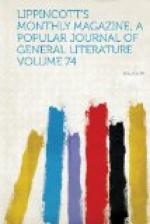Pekin was built by Kublai-Khan about 1282, near the site of an important city which dated from the Chow dynasty, or some centuries before the Christian era. The city covers an enclosed space about twenty miles in circumference. It is rectangular in form, and divided into two parts, the Chinese and the Tartar cities. The walls of the Tartar city are the largest and widest, being forty to fifty feet high, and, tapering slightly from the base, about forty feet wide at the top. They are constructed upon a solid foundation of stone masonry resting upon concrete, while the walls themselves are built of a solid core of earth, faced with massive brick: the top is paved with tiles, and defended by a crenelated parapet. Bastions, some of which are fifty feet square, are built upon the outside at distances of about one hundred feet. There are sixteen gates, seven of which are in the Chinese town, six in the Tartar town, and three in the partition wall between these two. In the centre of the Tartar city is an enclosure, also walled, called the Imperial City, and within this another, called the Forbidden City, which contains the imperial palaces and pleasure-grounds. Broad straight avenues, crossing each other at right angles, run through the whole city, which in this respect is very unlike other Chinese towns. A stream entering the Tartar city near its north-west corner divides into two branches, which enter the Imperial City and surround the Forbidden City, and then uniting again pass through the Tartar and Chinese towns, to empty in the Tung-Chau Canal.
The foreign legations are in the southern part of the Tartar city, on the banks of this stream. The top of the walls forms the favorite promenade of the foreign settlers, and from here a fine view of the whole city is obtained. M. de Beauvoir, however, from his more minute examination, comes to the following conclusions: “This immense city, in which nothing is repaired, and in which it is forbidden under the severest penalties to demolish anything, is slowly disintegrating, and every day changing itself into dust. The sight of this slow decomposition is sad, since it promises death more certainly than the most violent convulsions. In a century Pekin will exist no longer; it must then be abandoned: in two centuries it will be discovered, like a second Pompeii, buried under its own dust.”
The gates of Virtuous Victory and of Great Purity, the temples to the Heavens, to Agriculture, to the Spirit of the Winds and of the Thunder, and to the Brilliant Mirror of the Mind, occupied the attention of the party. They saw the gilded plough and the sacred harrow with which the emperor yearly traces a furrow to obtain divine favor for the crops, as well as the yellow straw hat he wears during this ceremony; and also the vases made of iron wire in which he every six months burns the sentences of those who have been condemned to death in the empire. They visited also the magnificent observatory built by Father Verbiest, a Jesuit, for the emperor You-Ching, in the seventeenth century. The instruments are of bronze, and mounted upon fantastic dragons, and are still in good condition, though they have been exposed to the open air all this time. One of them was a celestial sphere eight feet in diameter, containing all the stars known in 1650 and visible in Pekin.




